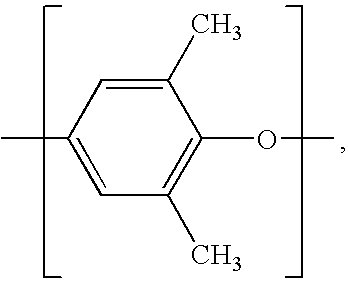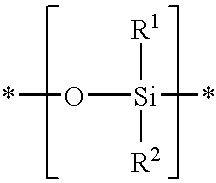Poly(arylene ether) composition and extruded articles derived therefrom
a technology of arylene ether and composition, which is applied in the direction of film/foil adhesive, record information storage, conductive materials, etc., can solve the problems of compromising esthetic problems, and reducing the flame retardancy of the composition
- Summary
- Abstract
- Description
- Claims
- Application Information
AI Technical Summary
Problems solved by technology
Method used
Image
Examples
embodiment 1
[0083]A composition, comprising: 5 to 55 weight percent of a poly(arylene ether)-polysiloxane block copolymer reaction product comprising a poly(arylene ether) homopolymer, and a poly(arylene ether)-polysiloxane block copolymer comprising a poly(arylene ether) block, and a polysiloxane block comprising, on average, 35 to 80 siloxane repeating units; wherein the poly(arylene ether)-polysiloxane block copolymer reaction product comprises 1 to 8 weight percent siloxane repeating units and 92 to 99 weight percent arylene ether repeating units; wherein the poly(arylene ether)-polysiloxane block copolymer reaction product is the product of a process comprising oxidatively copolymerizing a monomer mixture comprising a monohydric phenol and a hydroxyaryl-terminated polysiloxane; and wherein the poly(arylene ether)-polysiloxane block copolymer reaction product has a weight average molecular weight of at least 30,000 atomic mass units; 10 to 55 weight percent of a hydrogenated block copolymer...
embodiment 2
[0084]The composition of embodiment 1, wherein the poly(arylene ether)-polysiloxane block copolymer reaction product has a weight average molecular weight of 30,000 to 150,000 atomic mass units.
embodiment 3
[0085]The composition of embodiment 1 or 2, wherein the poly(arylene ether)-polysiloxane block copolymer reaction product has an intrinsic viscosity of 0.3 to 0.6 deciliter per gram as measured at 25° C. in chloroform.
PUM
| Property | Measurement | Unit |
|---|---|---|
| Temperature | aaaaa | aaaaa |
| Percent by mass | aaaaa | aaaaa |
| Percent by mass | aaaaa | aaaaa |
Abstract
Description
Claims
Application Information
 Login to View More
Login to View More - R&D
- Intellectual Property
- Life Sciences
- Materials
- Tech Scout
- Unparalleled Data Quality
- Higher Quality Content
- 60% Fewer Hallucinations
Browse by: Latest US Patents, China's latest patents, Technical Efficacy Thesaurus, Application Domain, Technology Topic, Popular Technical Reports.
© 2025 PatSnap. All rights reserved.Legal|Privacy policy|Modern Slavery Act Transparency Statement|Sitemap|About US| Contact US: help@patsnap.com



